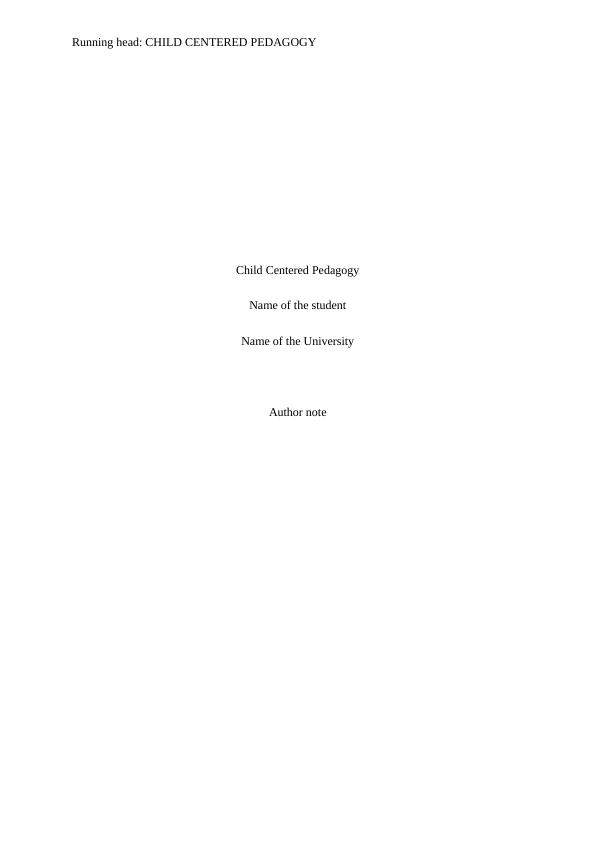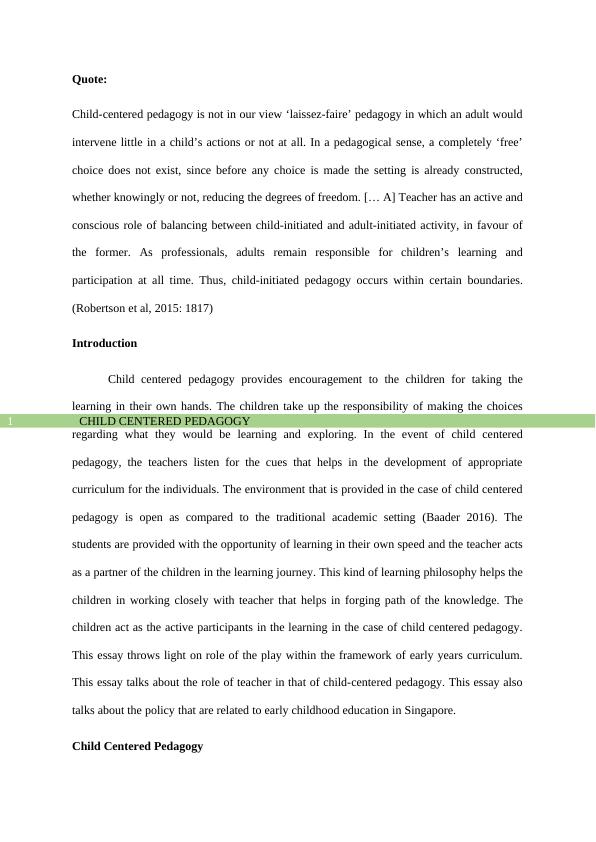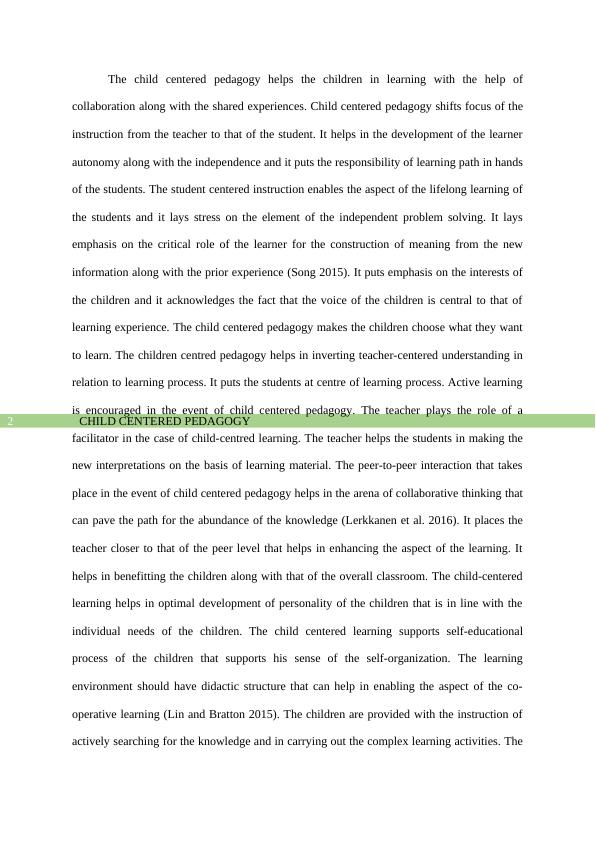Child Centered Pedagogy
Added on 2023-01-11
10 Pages2733 Words99 Views
Running head: CHILD CENTERED PEDAGOGY
Child Centered Pedagogy
Name of the student
Name of the University
Author note
Child Centered Pedagogy
Name of the student
Name of the University
Author note

CHILD CENTERED PEDAGOGY1
Quote:
Child-centered pedagogy is not in our view ‘laissez-faire’ pedagogy in which an adult would
intervene little in a child’s actions or not at all. In a pedagogical sense, a completely ‘free’
choice does not exist, since before any choice is made the setting is already constructed,
whether knowingly or not, reducing the degrees of freedom. [... A] Teacher has an active and
conscious role of balancing between child-initiated and adult-initiated activity, in favour of
the former. As professionals, adults remain responsible for children’s learning and
participation at all time. Thus, child-initiated pedagogy occurs within certain boundaries.
(Robertson et al, 2015: 1817)
Introduction
Child centered pedagogy provides encouragement to the children for taking the
learning in their own hands. The children take up the responsibility of making the choices
regarding what they would be learning and exploring. In the event of child centered
pedagogy, the teachers listen for the cues that helps in the development of appropriate
curriculum for the individuals. The environment that is provided in the case of child centered
pedagogy is open as compared to the traditional academic setting (Baader 2016). The
students are provided with the opportunity of learning in their own speed and the teacher acts
as a partner of the children in the learning journey. This kind of learning philosophy helps the
children in working closely with teacher that helps in forging path of the knowledge. The
children act as the active participants in the learning in the case of child centered pedagogy.
This essay throws light on role of the play within the framework of early years curriculum.
This essay talks about the role of teacher in that of child-centered pedagogy. This essay also
talks about the policy that are related to early childhood education in Singapore.
Child Centered Pedagogy
Quote:
Child-centered pedagogy is not in our view ‘laissez-faire’ pedagogy in which an adult would
intervene little in a child’s actions or not at all. In a pedagogical sense, a completely ‘free’
choice does not exist, since before any choice is made the setting is already constructed,
whether knowingly or not, reducing the degrees of freedom. [... A] Teacher has an active and
conscious role of balancing between child-initiated and adult-initiated activity, in favour of
the former. As professionals, adults remain responsible for children’s learning and
participation at all time. Thus, child-initiated pedagogy occurs within certain boundaries.
(Robertson et al, 2015: 1817)
Introduction
Child centered pedagogy provides encouragement to the children for taking the
learning in their own hands. The children take up the responsibility of making the choices
regarding what they would be learning and exploring. In the event of child centered
pedagogy, the teachers listen for the cues that helps in the development of appropriate
curriculum for the individuals. The environment that is provided in the case of child centered
pedagogy is open as compared to the traditional academic setting (Baader 2016). The
students are provided with the opportunity of learning in their own speed and the teacher acts
as a partner of the children in the learning journey. This kind of learning philosophy helps the
children in working closely with teacher that helps in forging path of the knowledge. The
children act as the active participants in the learning in the case of child centered pedagogy.
This essay throws light on role of the play within the framework of early years curriculum.
This essay talks about the role of teacher in that of child-centered pedagogy. This essay also
talks about the policy that are related to early childhood education in Singapore.
Child Centered Pedagogy

CHILD CENTERED PEDAGOGY2
The child centered pedagogy helps the children in learning with the help of
collaboration along with the shared experiences. Child centered pedagogy shifts focus of the
instruction from the teacher to that of the student. It helps in the development of the learner
autonomy along with the independence and it puts the responsibility of learning path in hands
of the students. The student centered instruction enables the aspect of the lifelong learning of
the students and it lays stress on the element of the independent problem solving. It lays
emphasis on the critical role of the learner for the construction of meaning from the new
information along with the prior experience (Song 2015). It puts emphasis on the interests of
the children and it acknowledges the fact that the voice of the children is central to that of
learning experience. The child centered pedagogy makes the children choose what they want
to learn. The children centred pedagogy helps in inverting teacher-centered understanding in
relation to learning process. It puts the students at centre of learning process. Active learning
is encouraged in the event of child centered pedagogy. The teacher plays the role of a
facilitator in the case of child-centred learning. The teacher helps the students in making the
new interpretations on the basis of learning material. The peer-to-peer interaction that takes
place in the event of child centered pedagogy helps in the arena of collaborative thinking that
can pave the path for the abundance of the knowledge (Lerkkanen et al. 2016). It places the
teacher closer to that of the peer level that helps in enhancing the aspect of the learning. It
helps in benefitting the children along with that of the overall classroom. The child-centered
learning helps in optimal development of personality of the children that is in line with the
individual needs of the children. The child centered learning supports self-educational
process of the children that supports his sense of the self-organization. The learning
environment should have didactic structure that can help in enabling the aspect of the co-
operative learning (Lin and Bratton 2015). The children are provided with the instruction of
actively searching for the knowledge and in carrying out the complex learning activities. The
The child centered pedagogy helps the children in learning with the help of
collaboration along with the shared experiences. Child centered pedagogy shifts focus of the
instruction from the teacher to that of the student. It helps in the development of the learner
autonomy along with the independence and it puts the responsibility of learning path in hands
of the students. The student centered instruction enables the aspect of the lifelong learning of
the students and it lays stress on the element of the independent problem solving. It lays
emphasis on the critical role of the learner for the construction of meaning from the new
information along with the prior experience (Song 2015). It puts emphasis on the interests of
the children and it acknowledges the fact that the voice of the children is central to that of
learning experience. The child centered pedagogy makes the children choose what they want
to learn. The children centred pedagogy helps in inverting teacher-centered understanding in
relation to learning process. It puts the students at centre of learning process. Active learning
is encouraged in the event of child centered pedagogy. The teacher plays the role of a
facilitator in the case of child-centred learning. The teacher helps the students in making the
new interpretations on the basis of learning material. The peer-to-peer interaction that takes
place in the event of child centered pedagogy helps in the arena of collaborative thinking that
can pave the path for the abundance of the knowledge (Lerkkanen et al. 2016). It places the
teacher closer to that of the peer level that helps in enhancing the aspect of the learning. It
helps in benefitting the children along with that of the overall classroom. The child-centered
learning helps in optimal development of personality of the children that is in line with the
individual needs of the children. The child centered learning supports self-educational
process of the children that supports his sense of the self-organization. The learning
environment should have didactic structure that can help in enabling the aspect of the co-
operative learning (Lin and Bratton 2015). The children are provided with the instruction of
actively searching for the knowledge and in carrying out the complex learning activities. The

End of preview
Want to access all the pages? Upload your documents or become a member.
Related Documents
Study Programs in Past Years Reportlg...
|12
|3396
|12
Actions Needed to Advocate For Play Pedagogies in Early Educationlg...
|9
|2566
|59
Pedagogy and Curriculum in the Early Yearslg...
|12
|4456
|147
A Child-Centered Theory of Learninglg...
|4
|764
|139
Subjectivity in Pedagogy: Importance in Understanding Children's Learning and Developmentlg...
|8
|2348
|315
Theories Principles and Models in Education and Traininglg...
|14
|3073
|453
